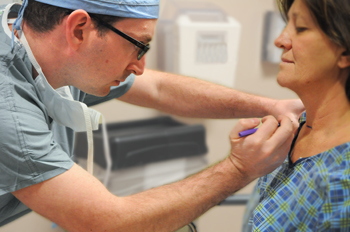Minimally Invasive Parathyroidectomy Options

Minimally invasive parathyroidectomy leads to smaller incisions, less pain and faster recovery than traditional open parathyroid gland surgery.
Treating a patient with primary hyperparathyroidism traditionally means a surgeon has to examine all four parathyroid glands to find and remove any that look or feel abnormal. But minimally invasive techniques, like endoscopic parathyroidectomy and others, provide an alternative to this traditional surgery and allow the surgeon to focus on removing just the gland that is causing the problem.
How does an endoscopic parathyroidectomy work?
This procedure is sometimes also known as minimally invasive video-assisted parathyroidectomy. The surgeon uses an endoscope, a thin tube that includes a light and a high-definition camera. The endoscope provides a magnified, highly detailed view of the parathyroid glands and the structures around them. This means an overactive parathyroid gland can be identified and removed without the need for open surgery.
After we remove the gland, but while the patient is still in surgery, we perform blood tests to check the patient’s parathyroid hormone levels. This helps us confirm that we’ve removed the overactive gland during surgery and cured the patient.
Is this procedure right for me?
Patients are excellent candidates for minimally invasive parathyroidectomies if we can identify their overactive parathyroid glands before surgery. We do this using ultrasounds or parathyroid scans. Your doctor will recommend the best surgical plan based on your condition.
Benefits of minimally invasive parathyroidectomy
Some of the benefits of minimally invasive parathyroidectomy as compared to traditional parathyroid gland removal surgery include:
- Much smaller incisions
- Can be performed under local anesthesia if patients prefer
- Less pain
- Shorter recovery time
- No sutures that need to be removed after surgery
- Outpatient surgery
- Reduced risk of injuring the other parathyroid glands
.svg?iar=0&hash=F6049510E33E4E6D8196C26CCC0A64A4)

/hfh-logo-main--white.svg?iar=0&hash=ED491CBFADFB7670FAE94559C98D7798)